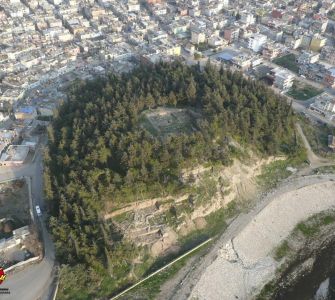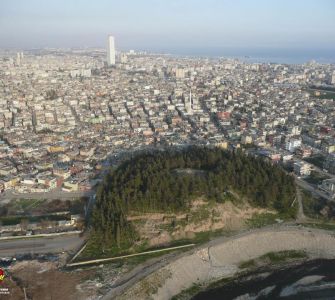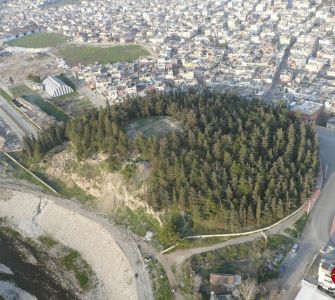Yumuktepe consists of 33 layers and its history is dated to 9000 years ago as a result of archaeological excavations. Therefore, it is an archeologically significant mound that sheds light on the life of 33 different historical periods.
History of Yumuktepe
It is known that the first settlement in Yumuktepe started about 9000 years ago by the farmers who migrated here by bringing seeds such as wheat, barley and lentils from the Fertile Crescent (Mesopotamia) in the polished stone (Neolithic) period. Again, it was understood that the first settlers were quite advanced in terms of ceramics, architecture and animal husbandry compared to that period. The remains of fruits such as olives, figs and pistachios, which are certain to have appeared in Anatolia for the first time in the world, also show that this society was advanced in agriculture. It has been understood that the knowledge and techniques of agriculture and animal husbandry spread over to the Aegean and Europe from Yumuktepe.
In the following periods, it is understood from the remains that this place was used as a settlement in the Bronze Age, the Copper and Iron Age, and the Antiquity and Medieval Ages. It was also determined that a defensive wall was built here during the Hittite period. Yumuktepe BC. It is understood from the ruins that it was an important center not only in agriculture but also in terms of architecture, ceramics, obsidian (volcanic stone) and stone tools until 7000 years ago. It is understood from the remains of a church belonging to this period that the settlement continued here during the Byzantine period. The food placed in 3 late bowls next to the 8000-year-old skeleton in a tomb in Yumuktepe shows that the people of that time also had a belief in an afterlife.
British Archaeologist John Gargstang carried out the first excavation in Yumuktepe in 1936, and these works stopped with the start of the Second World War. Gargstang identified 33 layers from the medieval Islamic civilization to the Stone Age.
Since 1993, Prof. Dr. Veli Sevin, Prof. Isabella Caneva and her delegation, consisting of scientists from other fields, started the "Yumuktepe Archaeological Excavation" studies. Hundreds of artifacts from Yumuktepe are exhibited in Mersin Museum. Yumuktepe is also included in the Tay (Turkish Archaeological Settlements) project inventory.
Yumuktepe Mound
Hills consisting of layers of old settlements in Anatolia are called Höyük (mound) among the people. The first settlement in Yumuktepe Mound was carried out by farmers in the Neolithic (polished stone) age, approximately 9000 years ago. The most important feature sought for settlement in the early ages was security and being close to streams. When the first settlement was destroyed/abandoned due to various disasters, wars, epidemics or other reasons, the people who came later reorganized this area, which was the most suitable for settlement, and built a new settlement on it, rather than looking for another place. .In this way; Yumuktepe has developed as 33 floors in Mersin, which has been a popular settlement throughout history due to its natural resources, harbor and location. Especially after the terraced houses were built on the previous ruins, the hill rose 23 meters compared to its original state. It has been understood that Yumuktepe was on the coast thousands of years ago, but over time, it became 3 km inland from the coast due to the alluvium carried by Müftü Creek.
Yumuktepe Story
There are various opinions about the origin of the name Yumuktepe. Although it is called Yumuktepe by the local people, it is also referred to as Soğuksutepe in archaeological sources. The archaeologist who started the first excavation here, Prof. J. Garstang named the mound as Yumuktepe. Scientist Charles Viktor Langlois mentions in his book that there is a castle called Yumuk Castle,. On a map of Paris, France, dated 1920, the name of this place is referred to as 'Yumrou Hill'. It is also mentioned in various sources that it is called Yumrutepe, and in a geography book, the creek next to the hill is called Yumuk River.
Where is Mersin Yumuktepe? Directions Information. How to go to Yumuktepe?
Yumuktepe is located in Mersin, 3km from the sea, by the Mufti Stream. Due to the development and growth of the city, it remained within the borders of Demirtaş Mahallesi. It is possible to reach here by private car or by public transport.
Today, hundreds of artifacts unearthed from this hill and itlooks like a picnic place covered with pine trees. Finds are exhibited in Mersin Archeology Museum, and we recommend that those who want to learn about Yumuktepe to visit this museum.








